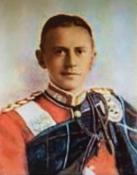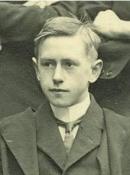
|
The King's School Canterbury |
Roll of Honour |
| Captain Ralfe Allen Fuller WHISTLER | |
|
2nd Battalion Highland Light Infantry Date of birth: 24th July 1895 Date of death: 28th April 1917 Died of wounds aged 21 Buried at Aubigny Communal Cemetery Extension Plot VI Row D Grave 7 |

|
| He was born in Glasgow on the 24th of July 1895 the younger son of Major Fuller Whistler MA JP, Highland Light Infantry, and Gwenllian Annie (nee Robinson) of Caldbec House, Caldbec Hill, Battle in Sussex. He was educated at Worcester Cathedral Choir School and at the King's School Canterbury from September 1909 to December 1912 on an entrance and probationary scholarship. He was appointed as a monitor in September 1912 and played for the Rugby XV in 1911,1912, and 1913. He became Hon Secretary for Rugby in January 1912 and also played for the Cricket XI in 1911 and 1912 being awarded his sports colours in the latter year. He was Captain of Games and won a number of prizes for athletics. He was a member of the Open Fives Doubles pair which won the annual school competition in 1912. He was also a member of the Officer Training Corps, reaching the rank of Sergeant in September 1912, and achieved Certificate A the same year. He was appointed as Captain of Cricket and as a member of the Sports Committee in 1912. Of his 1911 cricket season the Cantuarian wrote:- "Very fair bat who should do well next year. Must learn to play a bit straighter. Very fair field." Of his 1912 cricket season they wrote:- "A very fair bat with plenty of punishing power. Played three or four most useful innings. A good field." Of his 1911/12 rugby season the Cantuarian wrote:- "Vigorous and hard working forward, though at present a bit clumsy. Tackles well, and should be good next year." He passed 33rd in the examinations for the Royal Military College at Sandhurst where he won the prize cadetship and passed out 16th. He was commissioned as a 2nd Lieutenant in the 2nd Battalion Highland Infantry on the 24th of March 1914 and was stationed at Aldershot. He played cricket for his regiment. On the outbreak of war he embarked for France with his battalion on board the SS "Herschal" and the SS "Seahound" on the 13th of August 1914, landing at Boulogne at 5.30pm the following day. He saw action at the Battle of Mons and in the subsequent retreat before being wounded in the head by shrapnel at the Battle of the Aisne on the 16th of September 1914. He was evacuated to the rear and was loaded on board the SS "Carisbrook Castle" at St Nazaire on the 26th of September and arrived at Southampton the next day. He was considered well enough to be granted sick leave from the 28th of September and on the 11th of October 1914 a Medical Board sat at the Military Hospital Woolwich which reported: - "The Board find that he is suffering from a small puncture wound over the left parietal area. The wound has healed and X-ray shows no injury or foreign body. He still complains of some headache." On the 19th of October 1914 he joined his battalion at Purbrook Camp and joined the 4th Battalion of his regiment at Haddington on the 16th of February 1915 before returning to France where he joined his battalion in the field. On the 15th of May 1915 the 2nd Battalion Highland Light Infantry was in billets at Richebourg St Vaast during the battle of Festubert. Their billets came under shell fire during the morning and later in the day they received orders to man breastworks in the Rue Du Bois in support of an attack by 5th Brigade which to take place at 11.30am the next day. They arrived at the breastworks at 10.30pm. When the Brigade attack began they moved forward to occupy the vacated positions where they were subjected to heavy shelling for the rest of the day. Ralfe Whistler was wounded during the day and was evacuated to England where he spent some time at the Herbert Hospital at Woolwich. On the 30th of September 1915 a Medical Board was convened at the Military Hospital Edinburgh which recorded: - "This officer has recovered from his wound but the movement in the left thumb are permanently restricted." On the 20th of October a Medical Board which sat at the same hospital pronounced him as "fit for general service." On his recovery he was attached to the 1st Battalion of his regiment which was serving in Mesopotamia. He was promoted to Temporary Captain on the 31st of January 1916 and to Lieutenant in February 1916. He took part in the attempted relief of Kut during which he was slightly wounded for a third time by a bullet in the right leg on the 8th of March 1916. His life was saved when his pocket camera stopped another bullet which would have hit him in the heart. He was evacuated to Amara but returned to his battalion on the 8th of April. On the 26th of April 1916 he assumed command of the battalion. On the 18th of May 1916 he was evacuated to Basra Hospital suffering from paratyphoid fever and was invalided to Bombay on the 9th of June 1916, arriving there on the 15th of June. On the 27th of August 1916 he embarked for four months leave to England and was promoted to Captain in the same month. He embarked for France once again on the 22nd of March 1917 and re-joined the 2nd Battalion in the field at Rubempre on the 25th of March. On the 26th of April 1917 the battalion moved into trenches between Oppy Wood and Arleux, deploying with A and B Companies in the front line and with C and D Companies in support just in front of the sugar factory. On the 27th of April A and B Companies were withdrawn to the support line and to the sugar factory due to the heavy enemy shelling of the front line. During the day an enemy shell struck the sugar factory and caused an amount of German ordnance which was lying in the area to explode. The explosion wounded four officers and forty other ranks, including their commanding officer and Ralfe Whistler, who was wounded while trying to rescue his comrades. He was evacuated to a casualty clearing station where he died of his wounds the next day. The Chaplain, when writing to his parents, spoke of: - "The wonderful patience and bravery" he had shown. He is commemorated on the war memorial at Battle and on a stained glass window at Worcester Cathedral which is dedicated to the memory of their former Choristers who fell during the Great War. He is commemorated on the memorial at the Royal Military College Sandhurst. |
|
 | |
Back